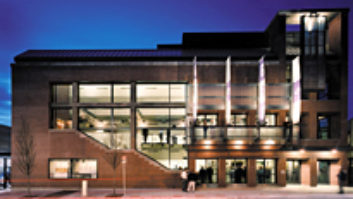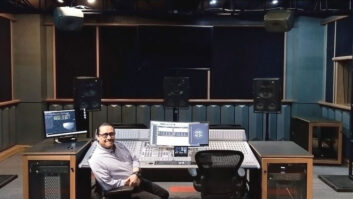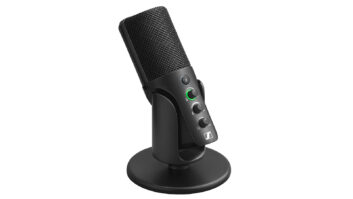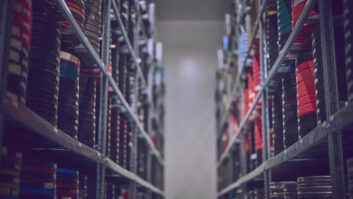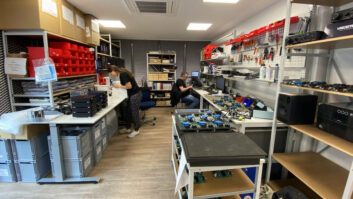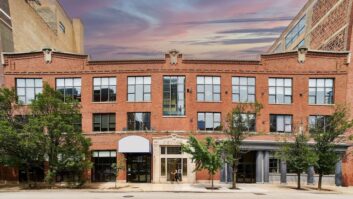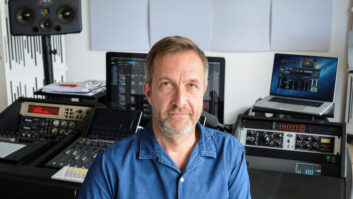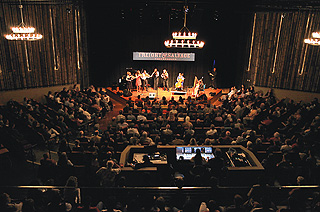
The Freight & Salvage Coffeehouse has been showcasing multicultural roots music since the venue was spawned by Berkeley, Calif., folkies in 1968. It has subsisted largely on a shoestring all these years, relying on devoted patrons and generous partners, such as Meyer Sound, for the resources to bring in such performers as bluegrass icon Ralph Stanley, singer/songwriter Loudon Wainwright III, Irish fiddle/guitar duo Martin Hayes and Dennis Cahill, New Orleans‘ Dirty Dozen Brass Band and so many others. Until six months ago, concertgoers were happy to crowd into the lovable dive that was The Freight’s home for more than 15 of its 42 years—a converted warehouse with exposed wood walls; counter-service coffee, tea and baked goods; and a collection of discarded folding and cafeteria chairs.
What a difference a decade makes. It took nearly 10 years of planning, fundraising, designing and redesigning, but The Freight finally has the home that its community of roots musicians and fans deserves. The new, larger venue opened this past August in downtown Berkeley, across from the city’s famed Berkeley Rep playhouse. The design of the new space resulted from a collaboration of The Freight’s executive director, Steve Baker, and technical director, Steve May, with several Bay Area-based consultant firms: acoustical consultants Charles M. Salter Associates; A/V designers The Shalleck Collaborative; architects Marcy Wong and Donn Logan; equipment providers ProMedia/UltraSound; and provider/patron Meyer Sound.
“My own involvement with The Freight goes back to 1999 or so when I started mixing there a couple nights a month,” says Meyer’s Pete Soper, who helped design the P.A. “Talk of the new space started shortly after I started there, but it was always this long-lost project: Someday we’ll move. When John and Helen Meyer heard what was going on, they wanted to help with the sound system, and since I was working at both places, I got to be the one to help spec the system. It went through a couple design iterations. When it was first talked about, our product offerings were different from what we have now. In ’01, we didn’t yet have any smaller-format curvilinear line array systems that would have been well-suited to this kind of space.”
The 440-seat listening room was fitted with L/R hangs of eight Meyer M’elodie speakers each, plus two 600-HP subwoofers under the stage, four stage-mounted M1D line array speakers for front-fills and three UPJ-1P VariOs for sidefills. Meyer’s Galileo speaker-management system is used for drive and processing.
Soper also worked with Ian Hunter of Shalleck Collaborative and May to select a new Soundcraft i4 console, which is used to mix FOH and monitors. “We were looking for something that’s not at the upper end, pricewise, because we are a nonprofit,” May says, “and something that would be fairly easy to get up and running, because we have maybe 12 local engineers who work here occasionally, and sometimes bands bring in their own engineer. We needed something with a small footprint so we wouldn’t have to give up too many seats, but more importantly we needed something straightforward and logically laid out. The Soundcraft offers a lot of flexibility, but it’s relatively easy to walk up and just start mixing a show.”
The room seats twice as many listeners as the old venue, but the seating arrangement—in a terraced fan shape, as opposed to the old venue’s shoebox shape—places more people closer to the music. The new building also retains some of the rustic feel of the old Freight, in a far superior acoustic environment. An existing space was gutted and the building trusses were removed; most were milled down to become the wood slats that are spaced along the auditorium’s side walls. Behind the wood planks is blackface insulation material. Together, the treatments contribute to a green, economical and sonically pleasing space.
“Part of that is perception,” offers Jason Duty of Charles M. Salter Associates. “Most people associate the look of wood with a warm-sounding space; people immediately feel like they’re walking into an instrument, like when you walk into the Disney Concert Hall, which is all wood and which we also worked on. The wood slats also diffuse the sound, give an organic feel and more life to the room. The blackface insulation is spongy and absorptive. Because they have such a wide range of groups, they wanted it to be good for a loud, raucous Zydeco band to come in and blow the paint—or wood—off the walls, but also work for a single guitarist who wants to play without amplification. It’s an important balance, and one of the reasons we do not have big absorptive panels all over the room sucking up the sound. We needed some reflection to get sound back to people when you have those smaller groups.”
In addition to the main listening room, the new Freight & Salvage includes several smaller practice room/classrooms that are used for educational outreach activities, such as workshops for adults and children who are learning a string instrument, and a summer Fiddle Camp for kids and teens. These auxiliary spaces were designed more simply and outfitted with Meyer’s Stella Series speakers. All of the spaces within The Freight are wired to the main listening room so that one can serve each other if needed.
The new Freight is also Leed-certified. “Eco-friendly is hard in production systems because the industry hasn’t really caught up to this movement, especially in lighting,” observes Shalleck Collaborative’s Hunter. “But the Meyer speakers are all self-powered, which helps because they only draw as much power as they require rather than running all the time. We also gave them the ability to turn the power to all equipment off at the end of the night via a main switch backstage. They have to go backstage to put mics and things away anyway, and I find that if you make it convenient for people, they’ll power down at the end of the night.
“This project really came together well using recycled materials and less energy,” Hunter says. “It’s a simple building in its essence, but the architects and everybody did a great job. We did it cheaply, but it never sounds cheap at all.”
“Our board and director worked tirelessly to make this place what it is,” May concludes. “There something about the old space that really worked because of the intimate size, but the benefits of this new space so outweigh that.”
